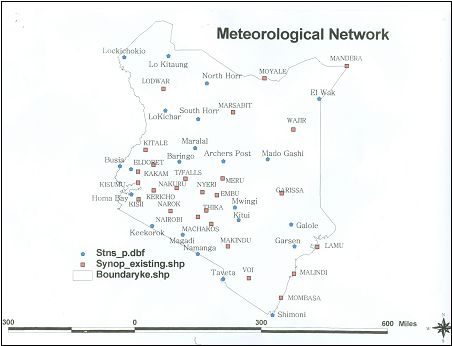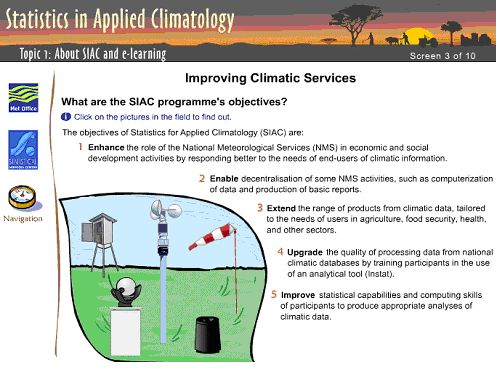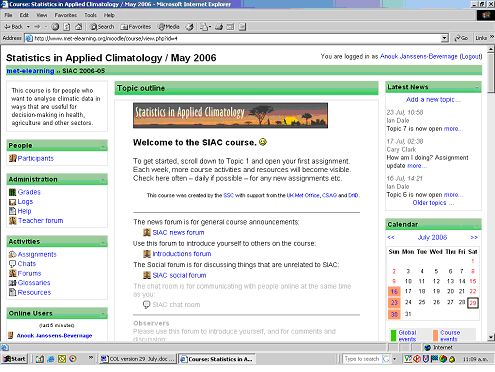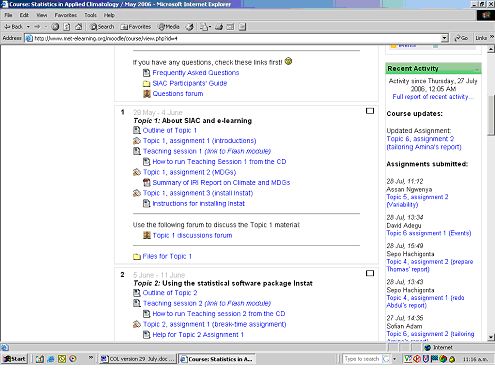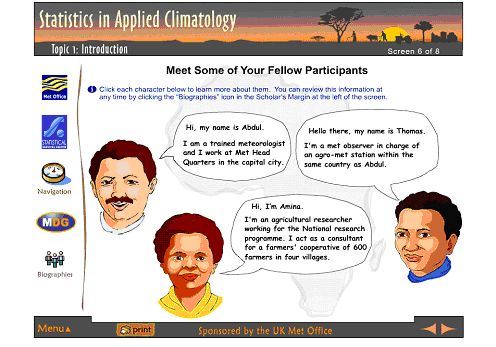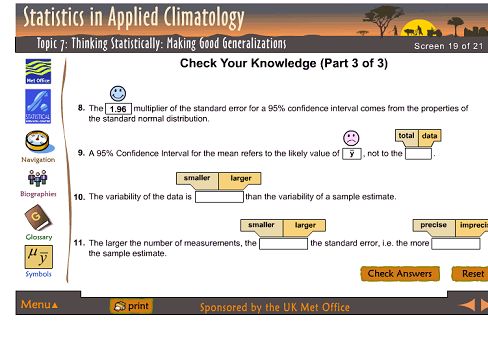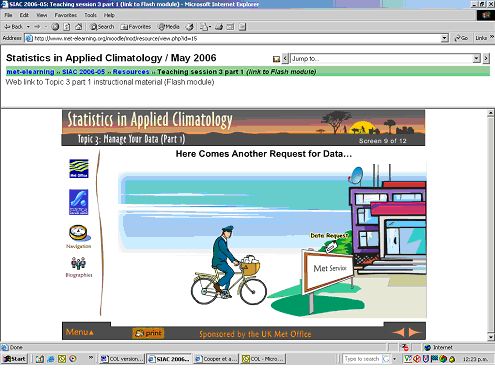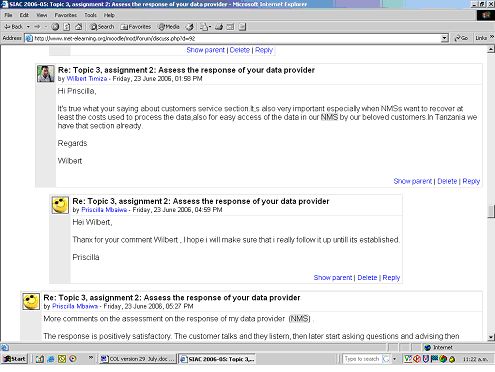|
Facilitated e-learning in sub-Saharan Africa Anouk Janssens-Bevernage, The Open Polytechnic of New Zealand Abstract
BACKGROUNDClimate change is in the news, and nowhere more so, than in Africa. For example, farmers are moving from the drought-prone South of Zambia, citing climate change as the reason their farming has become too risky. A local NGO is more convinced that their woes are rather caused by poor farming practices. Governments and donors are increasingly concerned that their efforts towards the 2015 Millennium Development Goals may be undermined by climate change. Hence there is considerable effort to support work to understand how to cope with climate change on a 10-year to 20-year time scale. There seems unanimity in the recommended approach. This is that understanding the current climate variability is useful itself and is also a necessary and possibly sufficient approach to dealing with short-term climate change, DFID (2005). In agriculture a recent theme paper is titled “Coping better with current climate variability in the rain-fed farming systems of sub-Saharan Africa: A dress rehearsal for adapting to future climate change?” Cooper et al (2006). Countries in Africa therefore need staff with the skills to analyse their heritage of historical climatic data. Each African country has a National Meteorological Service (NMS) and Kenya is taken as an example below. The NMSs have previously been more concerned with short-term forecasting, than with processing their climatic data. Hence their skills have been more towards physics and meteorology, than statistics. They are now keen to add skills of processing climatic data. Figure 1 shows the 35 Met stations in Kenya that are manned by staff of the Kenya Meteorological Department. They cover the country well. There are about 350 staff employed at these stations. Until recently only a few stations had computers. Instead staff sent data on paper to the headquarters in Nairobi. This changed in 2005 with the supply of computers for each station, supported by 2 weeks of training on basic computing and data entry. Most now enter the data locally and send them online or via diskette. The next step is to supply training in generating simple products, turning their stations into local resource centres for applications in their locality. Kenya typifies the motivation of African meteorological services to decentralise their climatic activities as part of their efforts to become more involved in development issues in their country.
Fig. 1: Climatic stations in Kenya manned by the Met Service (Courtesy Kenya Meteorological Department)
The SIAC training, described in this paper, is targeted towards both those who collect climatic data and also towards NGO, University or agricultural extension staff, etc., who are potential users of climatic information. Thus the audience includes those who need to recommend farming, or conservation practices, or advise on health, food security or other issues in situations where the vagaries of rainfall and other climatic elements are relevant. SIAC is designed to provide participants with the statistical skills they need to use historical datasets effectively. With such skills, people can produce relevant, tailored outputs that, in turn, enable users to make better decisions.
FROM SIAC TO e-SIACSIAC began in the 1980s as a 10-week course, given by the Statistical Services Centre, in the University of Reading, UK. Since 2000 the regional centre IMTR (Institute for Met Training and Research), based in Nairobi, has tailored the materials from SIAC to the needs of the Southern and Eastern African region. The course no longer runs in the UK, but has been further adapted and run in West and North Africa, in French. The objectives of SIAC are shown in Figure 2. Some are individual objectives, and others are objectives for the organisations, which send participants for the training.
Fig. 2: Objectives of SIAC
But a key problem remained. With the large number of countries and the expense of a regional course, only one person per country could be offered training in any one year. The countries could therefore never build the critical mass of trained staff, necessary to change the working practices in their service. In addition, the course had to be quite long, because many staff were weak in statistics. This was expensive and also took staff from their home duties for about 2 months. Hence discussions began in 2004 on the feasibility of achieving part of the SIAC objectives by providing initial training in an e-learning format. The e-SIAC component was designed to be as follows: · To cover the equivalent of up to 4 weeks of the original SIAC workshop · To be useful in its own right. · To allow larger numbers of staff from each country to have some training, and hence to build the critical mass of trained staff in each country. · To prepare selected participants for a shorter version of a subsequent face-to-face training. This is being given for the second time in 2006, and is now of 4-weeks duration.
THE e-SIAC PROGRAMMEThe e-SIAC training uses an online course page developed in Moodle, open source software to support Virtual Learning Environments (VLEs), (Figures 3 and 4).
Fig.3: The Virtual Learning Environment (Moodle course page)
Before the course starts, each participant is sent a pack of materials. It includes a participants' guide to online learning, a CD with the software, a colour guide introducing the statistical software package (Instat), and a guide to using the software for climatic analysis. There are a number of reasons for this ‘blended’ approach. It caters for different learning styles. Most of the teaching materials are provided on the CD, so following the course is feasible for those who have a computer without direct Internet access, provided they can easily get online elsewhere (e.g. at an internet café) to participate in discussions, submit assignments, etc. The online course page is the virtual training venue, where the participants can discuss problems and outcomes of the practical exercises supported by the online facilitators. Assignments are submitted online. The course page has a clear structure and flow, so participants know exactly what is expected from them, where they are in the course and where this is leading to. The learning content is offered in 8 attractive Flash animated visual training units with fictional characters who have similar roles and working environments to the participants’ professional context.
Fig.4: More of the Virtual Learning Environment
Figure 5 shows a screen from the first module of the e-learning course. It features three fictional characters that typify the intended audience for the training.
Fig. 5: Typical (fictional) participants on the e-SIAC training course
Participants must be computer literate and need regular access to a computer that has Internet connectivity and a CD or DVD drive. The course materials were developed with support from the UK Met Office and DFID. The early runs of the course are administered and facilitated by SSC staff. Later, staff from African organisations will become involved in the facilitation, as well as building further training materials.
DELIVERING e-SIACThe e-SIAC training is a facilitated on-line activity, taken over a 10-week period. The work is part-time and can be done at times of the day to suit the convenience of the individual participant. It takes at least five hours per week, (e.g. one hour per day); though most participants will need or wish to spend longer, perhaps up to 15 hours per week. Participants are strongly advised to seek permission – and expect encouragement – from their employers, so they can spend time on the training during their working week.
Fig. 6: Quizzes in the interactive training modules
The FLASH modules on the Moodle course page and on the CD, do include some quizzes, (Figure 6), but these are not to be submitted. The course developers have tried to minimise time that participants (with slow internet lines) need to be online. Because the discussion forums can only be accessed online, the preferred approach is a focus on peer and participant-tutor interaction on the course page while other resources are made available through the CD and paper-based course material. However, participants with a reasonable quality of Internet access can opt to access these resources on the course page.
Fig.7: The interactive training modules include many visual components referring to the professional context of the participants
The interactivity in the training modules is much more than clicking a mouse and following a hyperlink. Caplan (2004) warns against interactive tools that are implemented as “extras” or afterthoughts to the course. Oliver (2004) specifies that successful course development for on-line environments is based on choosing meaningful contexts for the learning activities and on making decisions about what the learners need to do, ahead of the content (Figure 7).
Communication is done in asynchronous discussion forums (in the Virtual Learning Environment) to allow for flexibility. Participants use the introductions forum to introduce themselves to the group. The social forum enhances social bonding online and includes ‘conversations’ about the world cup, travel plans, personal achievements like graduations, etc. (Figure 8). The course page also includes a general question forum for any clarifications needed that do not fit into the specific topic related discussion forums (Figure 9). The discussion forums are very popular despite being novel. In the first run of the course in 2005, the participants carried on using the e-SIAC space for discussions, four months after they completed the course.
Fig.8: A snapshot of the social forum
Salmon (2003) offers a five stage model of online teaching and learning which takes course delivery and facilitation through stage (1) access and motivation, (2) online socialization, (3) information exchange, (4) knowledge construction, and (5) development. In the next runs of e-SIAC the facilitators intend to improve on the first two stages by allowing the participants a longer exposure and introduction time. Icebreakers to improve socialisation, a clear strategy for enhanced peer-to-peer support should also enrich knowledge construction throughout the course. The structure of the discussion forums has developed considerably, during the 3 first runs of e-SIAC. An engaging and interactive discussion is an important pedagogical tool that helps to promote thinking (see for example, Berge and Muilenberg, 2002). Good discussions need to have a clear objective and be strategically moderated. Asking the right questions is crucial in stimulating a good discussion (Bender, 2003).
Fig.9: One of the many peer-to-peer discussions
The course typically has 2 or 3 pieces of assessment each week. They range from conventional "Example sheets" giving practice in the use of statistical software, to demands for information on the procedure and ease (or otherwise) with which participants acquired daily climatic data. Some assignments need a contribution to a discussion forum, while others require participants to upload a completed exercise in a Word file, which is then marked. Collaborative learning will soon be extended to underpin the assessment strategy, where peer-to-peer reflections on the assignments support the group’s learning process.
THE BENEFITS OF THE e-SIAC APPROACH TO e-LEARNINGBlending to ensure flexibilityThe course is a combination of a Virtual Learning Environment (the Moodle course page), a CD ROM, text-based materials and a face-to-face workshop. Only the participants who complete the online component - including the assignments - are invited to the face-to-face component. Can the course be offered without a face-to-face component? Technically speaking it could, but we should not underestimate the motivational power of a face-to-face meeting of participants who have worked together online for an extended period of time. Once there are larger numbers, the 4-week regional workshop will be supplemented by one-week within-country workshops, which can be focussed on consolidating the skills and on applying them to particular priorities within the country. At the other extreme, some countries may opt to use the training materials as support within a face-to-face course.
The right delivery mode for the interactive training unitsThe interactive training units are available on both the CD ROM and the Moodle course page. Including them on the course page ensures that the training units are integrated into a clear flow of scaffolding and collaboration to support the instruction. At any one time the participant knows where a specific training activity fits into the overall training strategy. Offering the same units on the CD enables participants with low bandwidth or irregular Internet access to engage in learning without dealing with potentially frustrating technology.
A virtual community of practiceAfrican National Meteorological Services face similar challenges in responding to demands from their communities. For example rain fed agriculture is important for all the countries and common questions relate to the start of the rainy season. Farmers usually want to plant their main cereal crop (e.g. maize) as early as possible, but early planting may run an excessive risk of a long dry spell, and thence the need for replanting. The generic nature of the challenges faced by staff in different countries contributes to the value of fostering the community of practice, which can be initiated by e-learning. The ease with which participants can continue their discussions, following the training, is also valuable as they apply their new skills. Building a sense of community also ensures that Met service staff and others, appreciate that they are not alone when facing the numerous challenges in their work. To be able to build this community, it is important to work with the right Virtual Learning Environment software. Moodle offers many benefits in terms of ensuring structure and flow in the learning process, and at the same time user-friendly enabling tools to collaborate and build a virtual community. The course team appreciates that informal learning is a useful approach to online curricula (Driscoll, M. and Carliner, S., 2005) and intends to further explore its learning design strategies.
The use of open source softwareThe idea behind open source software is that programmers from around the world work collaboratively and voluntarily to improve software, which is made available for free to all. Opting for an open source course management system (Moodle) permits other organisations to learn from the experience and use the same software platform for other initiatives, should they so wish. The experience with Moodle as a virtual learning environment was very positive for both facilitators and course participants.
CONCLUSION AND FUTURE DEVELOPMENTSThe facilitators’ involvement and feedback prove to be very powerful support for the learner. Some participants lack confidence in their abilities in this new area. Hence the facilitation and feedback has assumed much greater importance than had been expected. Many online courses consist of only instructional material (unsupported web-based trainings) and others provide a forum for exchange. e-SIAC’s strength lies in the combination of all elements of online learning in one design called ‘blended learning’. As a result an engaging and inspiring educational environment was created. Most of the resources were devoted to developing the FLASH sessions, and the development team were fortunate to be supported to be able to do this. In future courses, it is clear that it is the whole “learning package” that is needed, including the instructional design of the virtual learning environment. This requires specific skills. If a future course had to be undertaken with a lower initial budget, then it could start with simpler lessons, for example using a well-designed Power Point show. The most important feature of the course is the virtual learning environment. The SIAC stakeholders originally thought that the existing SIAC content would provide a good basis for the FLASH materials. In hindsight it was not of sufficient quality. The e-learning materials forced a higher standard in clarifying objectives, assessing what was feasible in a single session, etc. In a taught course it is easy to hide lack of clarity in objectives by additional explanations and expressive hand waving, which is not available in an e-learning environment. Thus developing these materials has had the side benefit of supporting potential improvements to the face-to-face courses. The e-SIAC development team continuously enhances the way in which the online training is offered. For example in the November 2006 run it is planned to include group work as well. Problem solving in groups should be part of the online learning environment to promote similar professional practices in real life. The high level of participation in e-SIAC is not surprising considering the eye-opening experience for otherwise very isolated professionals and given the cultural bias towards celebrating communication and community. However, the levels of participation exceed the course developers’ expectations in view of the sometimes-difficult circumstances in which participants access the Internet and the fact that statistics is still often regarded as a difficult – even evil subject. The quality of the course and the online facilitation seem to give ample motivation to go the extra mile (very often in a literal sense) to get access to the e –learning component of the course. We hope we have made progress in making even this topic accessible. We also believe that we can inspire other educational programmes offered in developing countries to make learning more accessible and learning journeys more engaging through the use of e-learning technologies.
REFERENCES
Bender, T.(2003). Discussion-based Online Teaching to Enhance Student Learning, Stylus, Sterling, Virginia Berge, Z., and Muilenburg, L.(2002). A Framework for Designing Questions for Online Learning, Berge Collins Associates [available online] www.emoderators.com/moderators/muilenburg.html Caplan, D. (2004). The Development of Online Courses. In Anderson, T. and Elloumi, F. (Eds.). Theory and Practice of Online Learning, Athabasca University, [available online] www.cde.athabascau.ca/online_book Cooper, PJM, Dimes, J, Rao, KPC, Shapiro, B and Twomlow, S, (2006). Coping better with current climate variability in the rain-fed farming systems of sub-Saharan Africa: A dress rehearsal for adapting to future climate change? Global Theme on Agroecosystems Report no 27, ICRISAT DFID (2005). Climate Proofing Africa – Climate and Africa’s Development Challenge, Crown Driscoll, M. and Carliner, S. (2005). Advanced Web-based Training Strategies, Pfeiffer, San Francisco Oliver, R.(2000). When Teaching Meets Learning: Design Principles and Strategies for Web-based Learning Environments that Support Knowledge Construction [available online] www.ascilite.org.au/conferences/coffs00/papers/ron_oliver_keynote.pdf Salmon, G.(2003). E-moderating: The Key to Teaching and Learning Online, Routledge Falmer, London and New York
Figures |
